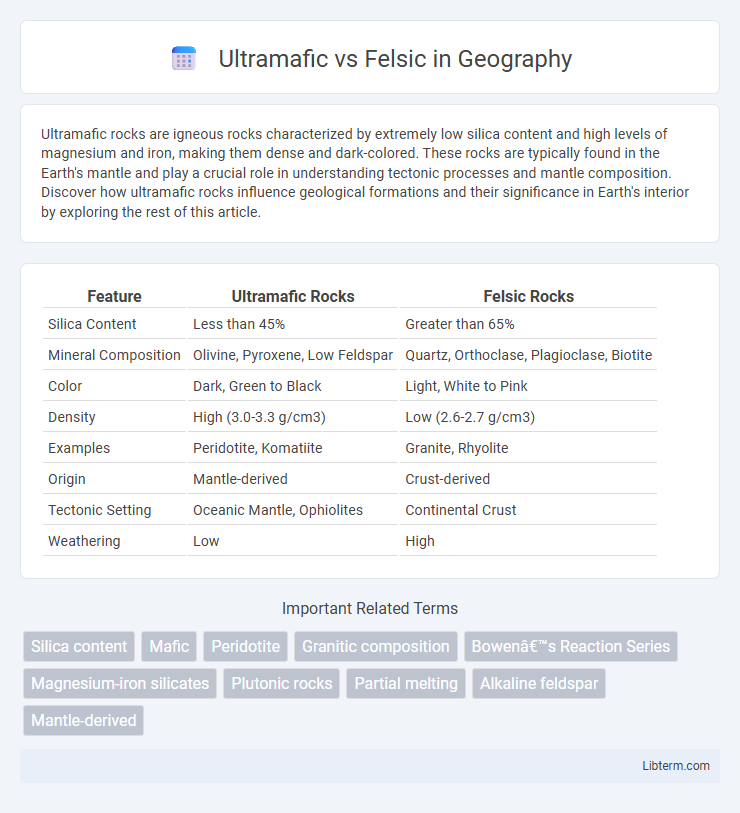Ultramafic rocks are igneous rocks characterized by extremely low silica content and high levels of magnesium and iron, making them dense and dark-colored. These rocks are typically found in the Earth's mantle and play a crucial role in understanding tectonic processes and mantle composition. Discover how ultramafic rocks influence geological formations and their significance in Earth's interior by exploring the rest of this article.
Table of Comparison
| Feature | Ultramafic Rocks | Felsic Rocks |
|---|---|---|
| Silica Content | Less than 45% | Greater than 65% |
| Mineral Composition | Olivine, Pyroxene, Low Feldspar | Quartz, Orthoclase, Plagioclase, Biotite |
| Color | Dark, Green to Black | Light, White to Pink |
| Density | High (3.0-3.3 g/cm3) | Low (2.6-2.7 g/cm3) |
| Examples | Peridotite, Komatiite | Granite, Rhyolite |
| Origin | Mantle-derived | Crust-derived |
| Tectonic Setting | Oceanic Mantle, Ophiolites | Continental Crust |
| Weathering | Low | High |
Introduction to Ultramafic and Felsic Rocks
Ultramafic rocks are igneous formations composed primarily of olivine and pyroxene, with very low silica content, usually less than 45%, making them dense and rich in magnesium and iron. Felsic rocks, in contrast, contain high silica content, typically above 65%, and are dominated by minerals such as quartz, feldspar, and mica, resulting in lighter, less dense compositions. These fundamental differences in mineralogy and silica content define their distinct physical properties and geological significance.
Definition of Ultramafic Rocks
Ultramafic rocks are igneous rocks composed predominantly of mafic minerals such as olivine and pyroxene, containing less than 45% silica content. These rocks are typically found in the Earth's mantle and are characterized by high magnesium and iron concentrations, which give them a dense and dark appearance. Ultramafic rocks contrast sharply with felsic rocks, which have higher silica content and are rich in lighter minerals like quartz and feldspar.
Definition of Felsic Rocks
Felsic rocks are igneous rocks rich in silica and light-colored minerals such as quartz, feldspar, and muscovite, contrasting with ultramafic rocks that contain high amounts of magnesium and iron and low silica content. These rocks typically form from magma with high silica content, resulting in lighter textures and compositions. Examples of felsic rocks include granite and rhyolite, characterized by their pale color and abundant feldspar and quartz minerals.
Mineral Composition Comparison
Ultramafic rocks predominantly contain high amounts of olivine and pyroxene, with low silica content typically below 45%, resulting in a dense, dark mineral composition. Felsic rocks are rich in quartz, potassium feldspar, and plagioclase feldspar, featuring silica content above 65%, which imparts a lighter color and lower density. The contrasting mineralogy between ultramafic and felsic rocks reflects their formation through different magmatic differentiation processes and mantle-crust sources.
Color and Texture Differences
Ultramafic rocks typically display dark green to black colors due to high concentrations of magnesium and iron-rich minerals like olivine and pyroxene, with a coarse-grained texture that often appears dense and heavy. In contrast, felsic rocks exhibit lighter colors ranging from white and pink to light gray, dominated by minerals such as quartz and feldspar, and generally have a finer to medium-grained texture with a more granular and less dense appearance. These distinct color and texture differences arise from their contrasting mineral compositions and crystallization processes.
Formation Processes
Ultramafic rocks primarily form in the Earth's mantle through high-temperature partial melting of peridotite, leading to magnesium- and iron-rich compositions. Felsic rocks originate in the continental crust from the partial melting of silica-rich materials such as granite and rhyolite, characterized by high silica and aluminum content. These formation processes result in distinct mineralogy, with ultramafic rocks containing olivine and pyroxene, while felsic rocks are dominated by quartz and feldspar.
Geological Occurrences
Ultramafic rocks predominantly occur in Earth's mantle and are exposed at tectonic plate boundaries such as ophiolites and mantle xenoliths, characterized by high magnesium and iron content with low silica. Felsic rocks are commonly found in continental crust, particularly in areas of volcanic arcs and large batholiths, featuring high silica content and abundant quartz and feldspar minerals. These geological occurrences reflect the contrasting formation environments, with ultramafic rocks linked to mantle processes and felsic rocks associated with crustal magmatism and continental differentiation.
Economic Importance
Ultramafic rocks, rich in magnesium and iron, are economically important for their deposits of valuable minerals such as chromite, nickel, and platinum group elements, often mined for industrial and technological applications. Felsic rocks, characterized by high silica content and abundant quartz and feldspar, are significant for producing construction materials like granite, as well as hosting precious metal ores including gold and tin. Both rock types contribute to the mining industry, with ultramafic rocks typically targeted for base metals and platinum-group metals, while felsic rocks are crucial for industrial minerals and precious metal extraction.
Weathering and Erosion Patterns
Ultramafic rocks, rich in magnesium and iron, exhibit intense chemical weathering due to rapid breakdown of olivine and pyroxene minerals, often resulting in thick lateritic soils with high iron and aluminum content. Felsic rocks, composed mainly of quartz and feldspar, weather more slowly and physically, producing sandy and clay-rich soils due to the relative stability of quartz during erosion processes. The contrasting mineralogy drives distinct erosion patterns, with ultramafic terrains showing accelerated topsoil depletion and felsic regions maintaining more stable landscape profiles over time.
Key Takeaways: Ultramafic vs Felsic
Ultramafic rocks contain more than 90% mafic minerals like olivine and pyroxene, resulting in high magnesium and iron content with low silica levels below 45%. Felsic rocks are rich in silica (above 65%) and light-colored minerals such as quartz and feldspar, leading to lower density and higher viscosity in magmas. The distinct chemical compositions influence rock color, density, melting temperatures, and tectonic classifications between ultramafic and felsic types.
Ultramafic Infographic

 libterm.com
libterm.com